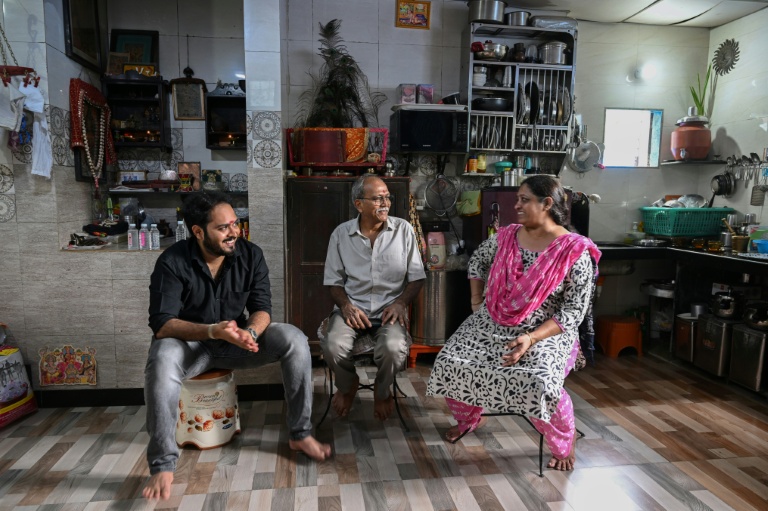World
Mumbai’s Dharavi Slum Faces Redevelopment: Residents Struggle

In Mumbai, India, the redevelopment project of Dharavi, Asia’s largest slum, is set to uproot thousands of residents. The initiative, backed by billionaire Gautam Adani, aims to transform the densely populated area into a new urban landscape. As bulldozers prepare to move in, residents like Bipinkumar Padaya express their despair. “I was born here… But we don’t have any choice, we have to vacate,” said the 58-year-old government employee. The redevelopment scheme has raised concerns about the fate of the community’s approximately one million inhabitants.
Dharavi, covering 240 hectares, is home to nearly 350,000 people per square kilometre, making it one of the most densely populated areas globally. It has served as both a hub of informal industry and a vibrant community, where potters, tanners, and recyclers contribute roughly $1 billion annually to India’s economy. The area gained international attention when it was featured in Danny Boyle’s award-winning film, “Slumdog Millionaire,” though many residents feel this portrayal oversimplifies their reality.
In a recent statement, SVR Srinivas, Chief Executive of the Dharavi Redevelopment Project (DRP), emphasized the project’s potential. “This is the world’s largest urban renewal project,” he stated, highlighting plans to create a “city within a city.” Residents will reportedly receive housing, with families living in Dharavi prior to 2000 qualifying for free accommodation. Those who arrived between 2000 and 2011 can purchase homes at a discounted rate, while newcomers will need to find housing elsewhere.
Nevertheless, a significant portion of Dharavi’s residents, including those living in illegally built upper floors, may find themselves excluded from these benefits. Manda Sunil Bhave, a local resident, expressed hope for improvement but acknowledged the uncertainty facing her neighbors. “We want to get out of the slums… But we do not want them to push us out of Dharavi in the name of development,” said Ullesh Gajakosh, leader of the “Save Dharavi” campaign.
As the redevelopment progresses, concerns grow about the impact on local businesses. Abbas Zakaria Galwani, a potter, emphasized the importance of retaining space for artisans. “If Adani doesn’t give us as much space… we will lose,” he warned. Critics point out that the project may serve corporate interests more than the needs of current residents.
Opposition to the plan is not limited to locals. Shweta Damle from the Habitat and Livelihood Welfare Association criticized the project’s intentions, stating, “This project has nothing to do with the betterment of people’s lives.” She expressed concern that as many as three-quarters of Dharavi’s residents might be forced to relocate, leading to the loss of an entire ecosystem.
Adani’s group won the redevelopment contract, pledging to invest around $5 billion and control 80 percent of the project. The Indian government anticipates the overall cost could reach $7–8 billion, with hopes of completion within seven years. With significant power and influence, Adani’s role has made him a focal point for criticism.
As Mumbai grapples with this controversial project, the fate of Dharavi hangs in the balance. The redevelopment promises modern conveniences but represents a profound shift for a community that has thrived for generations. The voices of residents like Padaya, Bhave, and Gajakosh reflect the complex emotions surrounding this transformation—hope for a better life mixed with fear of displacement and loss.
-

 Science2 months ago
Science2 months agoToyoake City Proposes Daily Two-Hour Smartphone Use Limit
-

 Health2 months ago
Health2 months agoB.C. Review Reveals Urgent Need for Rare-Disease Drug Reforms
-

 Top Stories2 months ago
Top Stories2 months agoPedestrian Fatally Injured in Esquimalt Collision on August 14
-

 Technology2 months ago
Technology2 months agoDark Adventure Game “Bye Sweet Carole” Set for October Release
-

 World2 months ago
World2 months agoJimmy Lai’s Defense Challenges Charges Under National Security Law
-

 Technology2 months ago
Technology2 months agoKonami Revives Iconic Metal Gear Solid Delta Ahead of Release
-

 Technology2 months ago
Technology2 months agoSnapmaker U1 Color 3D Printer Redefines Speed and Sustainability
-

 Technology2 months ago
Technology2 months agoAION Folding Knife: Redefining EDC Design with Premium Materials
-

 Technology2 months ago
Technology2 months agoSolve Today’s Wordle Challenge: Hints and Answer for August 19
-

 Business2 months ago
Business2 months agoGordon Murray Automotive Unveils S1 LM and Le Mans GTR at Monterey
-

 Lifestyle2 months ago
Lifestyle2 months agoVictoria’s Pop-Up Shop Shines Light on B.C.’s Wolf Cull
-

 Technology2 months ago
Technology2 months agoApple Expands Self-Service Repair Program to Canada









